A Brush with Life - Issue #83 No Moving Mountains
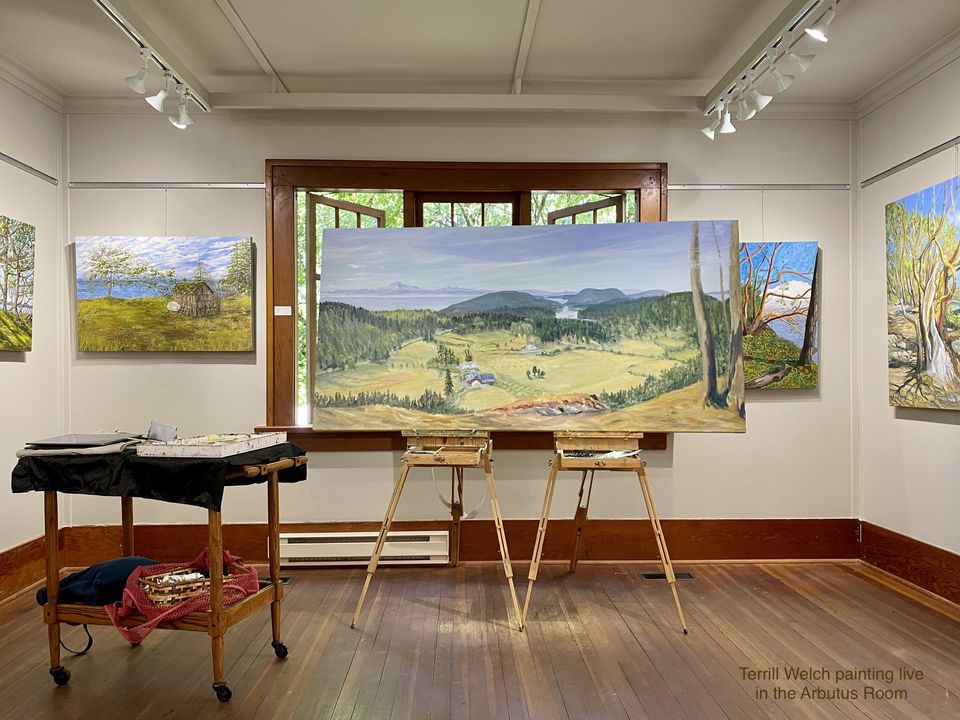
Change the angle of the rocks, shift the trees, leave out a fence but it is best not to move the mountains! These large objects are often our most significant directional anchor. This is important to any of us who still use North, East, South and West to get our bearings - as a way of finding and placing ourselves in our natural world (rather than relying on Google maps). This allows me to walk and drive around by what I call “following my nose” when I don’t know exactly where I am going. I can say things to myself like… I will just keep to the southeast slope and I should be able to find the look out. This is how I know where the sun will rise at different times of the year and, if I have the coordinates, I can find where the full moon will rise as well. I am quite clear now that not everyone has this kind of directional mind-map-squaring-up of where they are located in relation to everything else. I am often still puzzled by this realization. How do you know where you are if you don’t know which way is which? How can you even decide where to sit in the shade of a patio if you don’t know where the sun will be in an hour? Aaah! But I digress. Mountains! In particular Mount Baker which for us on Mayne Island is to the East. If you face the mountain and turn to the right of it, you are facing South. If you turn left of it, you are facing North. If you put your back to it, you can watch the sunset in the West. This mountain is a quick visual orientation shortcut. Yes, the sun rises and sets in a huge range of places on either side of this mountain depending on the season. As expected in our northern hemisphere, it will rise farther North on longer days during the summer and farther South on shorter days during the winter.
Yes, I can translate for you when I am giving directions. When I say something like, “just keep heading South along…..” and I get a kind of panicked stare in return, I can actually stop mid-sentence, find a landmark in my mind’s visual reference files and say something like “as you come out of the building, turn to the left and you will see the library building a little farther along on your right across from our small shopping centre. Drive up the little hill and keep going on this road and you will eventually come to the ferry terminal in about ten minutes.”
Usually the relief on your face, tells me this is a much better method for how you make sense of your surroundings. Both methods have their usefulness and one can work better than the other in specific situations. However, I get this horrible unsettled feeling when I can only go by left and right or behind and in front of directions that are most useful in the dark or oddly enough when I have to go on a subway and come back to the surface. These are times when I must rely on finding my way without really knowing where I am. Gives me shivers just to think about it! My dear husband says I would get use to it if I never knew, like him. And to be truthful, I have never known anyone who was calmer or more relaxed than he is.
So no worries, you will get to where you are going no matter which way you figure out how to get there…. As long as no one moves the Mountains! 😉
What does all this have to do with landscape painting you might ask? Well, let’s see…
Did You Take Any Artistic licenses?
As you might remember from our last issue, I have been painting a grand view live on a large 36 x 72 inch canvas in the gallery’s Arbutus Room. People come in while I am painting and say things like “I live just over there behind that hill” and the another person say “I live just over here” and they point to the other side of the canvas. I suspected this was might happen so I did my best to be true to marking out the shape of each hill and distant island in relationship to each other and to Mount Baker in the far distance. The painting isn’t finished yet but it is getting closer and certain aspects are starting to take shape. Would you like to see?

How about we take a bit closer look and I will see if I can get some of the shiny wetness to be less apparent? How is this?…
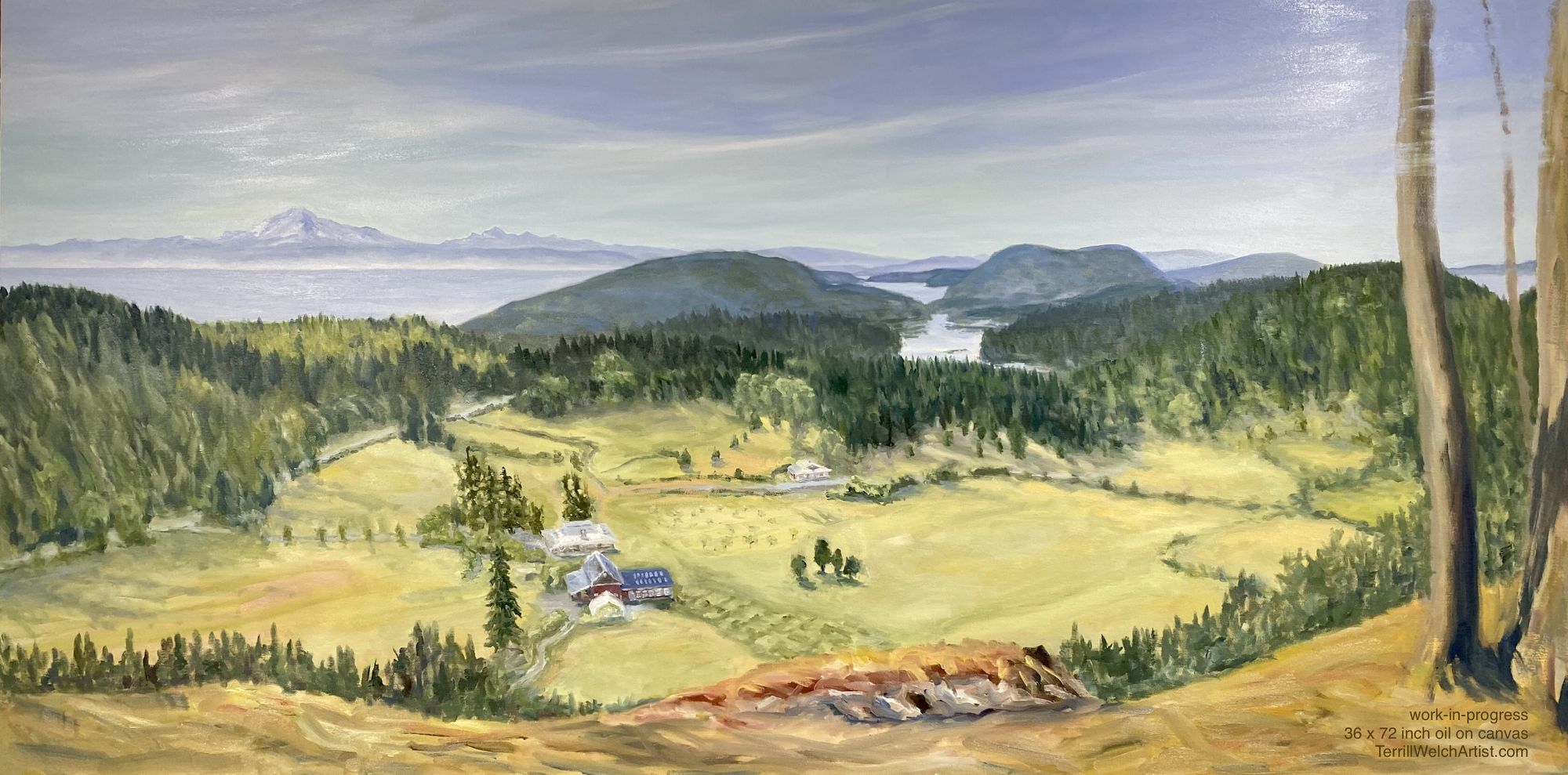
Well, somewhat better at least. Enough so that I think you can get the idea. This is about the stage the painting was the other day when someone asked me if I had taken any artistic licenses with the view. I replied that yes I had taken a few with the edge of the cliff and where I placed the trees on top and that a large cedar that partially impaired the view was not going to be put in the painting.
She nodded and pointed “but what about this?”
“Mount Baker?” I question and she nods.
“No” I reply, “on a clear day Mount Baker is there but it is maybe slightly larger and more imposing than I have painted it.”
”Really!?” she commented with surprise.
I nodded. Then I thought, I had best have photographic proof on hand in the future. So here it is…
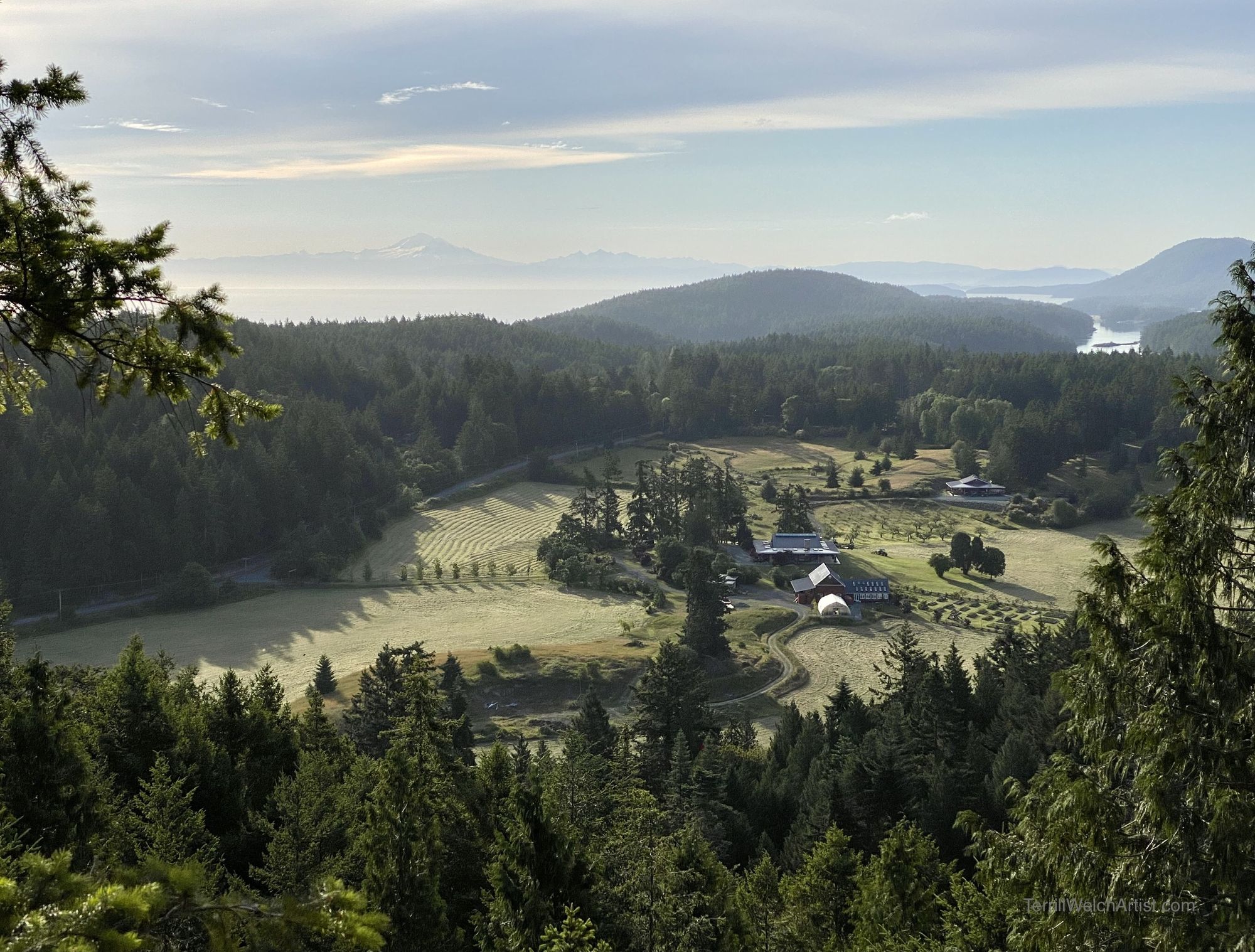
Mount Baker, as you can likely guess, is one of my major reference points as I am composing and painting this rather complex grand view. So no moving mountains! Just a few trees and the cliff line slightly. 😉
New Release
Jody Waldie is truly the queen of underpainting amongst the gallery artists. Only those that paint beside her or visit her studio get to see these magnificent works before the overpainting happens. The gallery would like to share with you some of these rarely glimpsed beauties and in the process of preparing for this possibility it has resulted in this new release of a large 60 x 48 inch work that Jody painted last year…
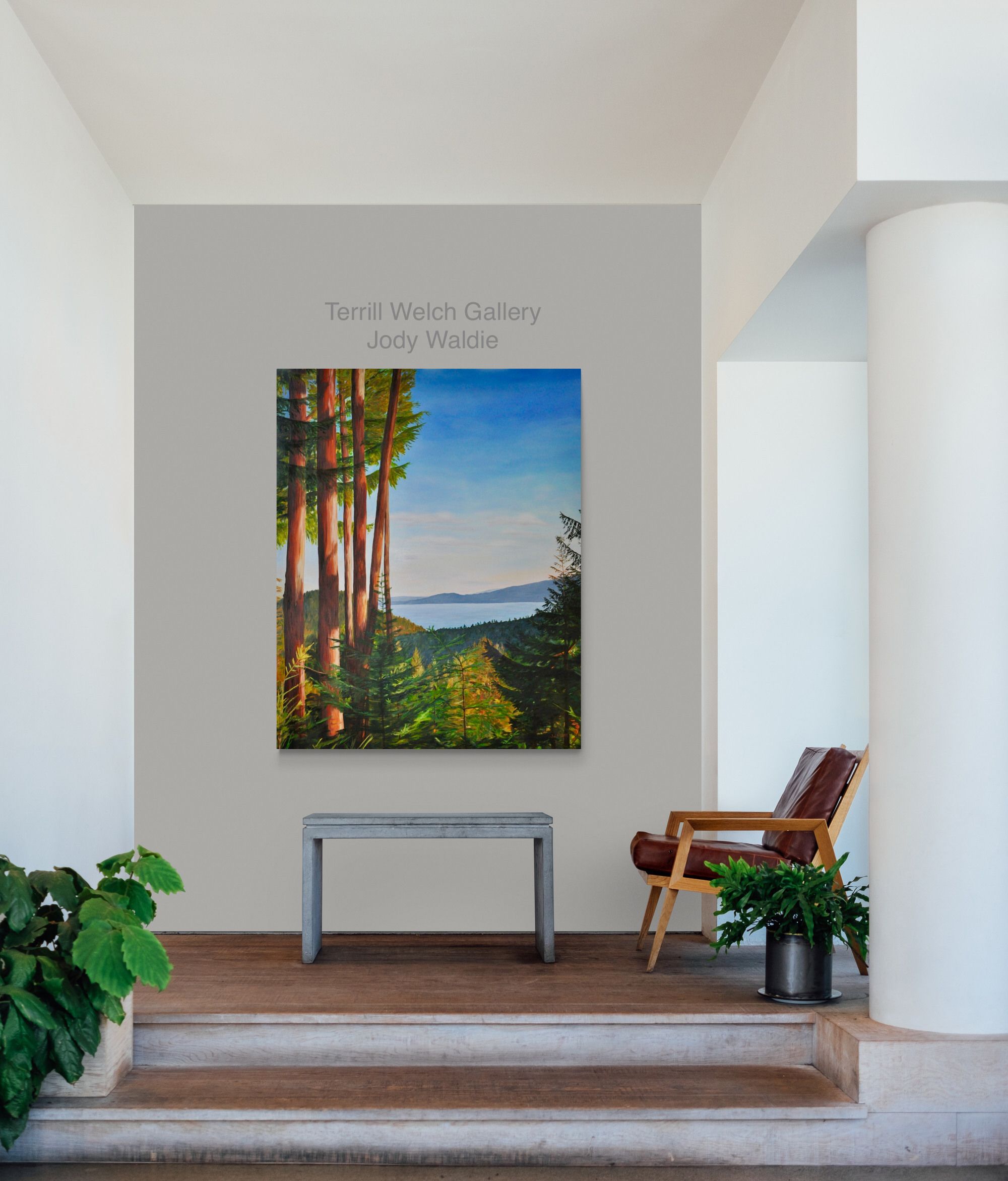
And here is the direct link to the painting in our Artsy online gallery…

Jody Waldie | One Late Afternoon (2020) | Available for Sale | Artsy
Available for sale from Terrill Welch Gallery, Jody Waldie, One Late Afternoon (2020), Oil on canvas, 60 × 48 in
Underpainting and the work of Jody Waldie
Underpainting has a long history and art historians believe it was pioneered by Titian in the 1500’s. Later, underpainting was used in a slightly different way by da Vinci and Rembrandt to help create the structure of the painting and understand the colour values and light effects for the overpainting. Underpaintings can be opaque or translucent, monochrome or multi-colour, quite detailed or more roughly laid out onto the canvas. The one thing that seems to be consistent, at least in oil painting, is that for there to be an underpainting, there needs to be an overpainting. In fact, possibly only hints of the underpainting will show through in the finished painting. You have seen many of my underpaintings over the years but now I want to show you something quite special and share Jody Waldie’s underpaintings along with the corresponding finished paintings that are listed with the gallery.
This first underpainting is for the finished painting above. You will see in this painting that she also used a grid system to make the translation from her references easier to keep in scale or proportion as she started the work on the large canvas.
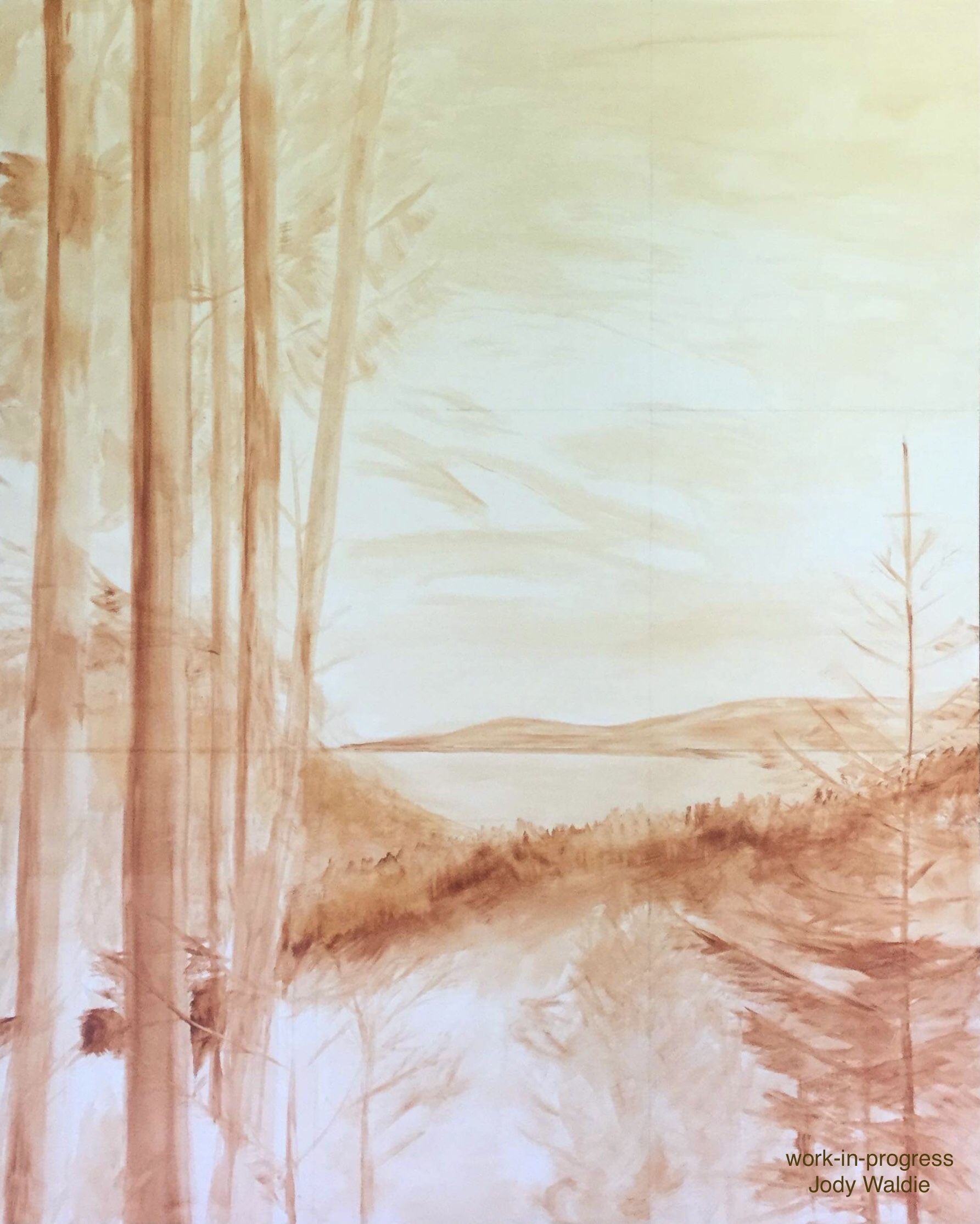
If we follow along, we can see how the underpainting guides her overpainting as she begins to block in the work on the canvas.
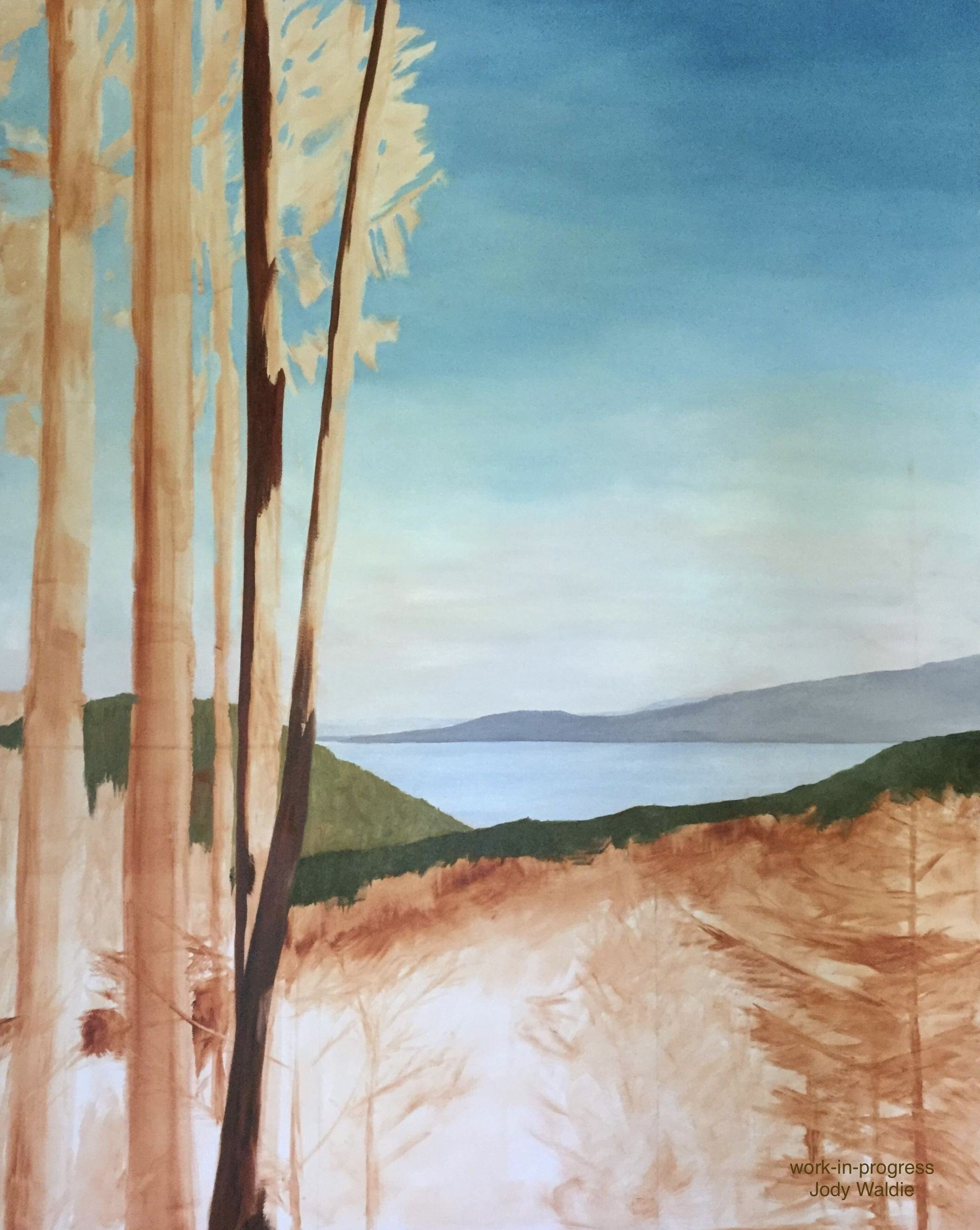
Let’s look at another work and see how it developed. In this case, Jody did red underpainting plus a colour study from her reference so that she could distinguish and render the various shades of green in the foliage as the sun was streaming through.
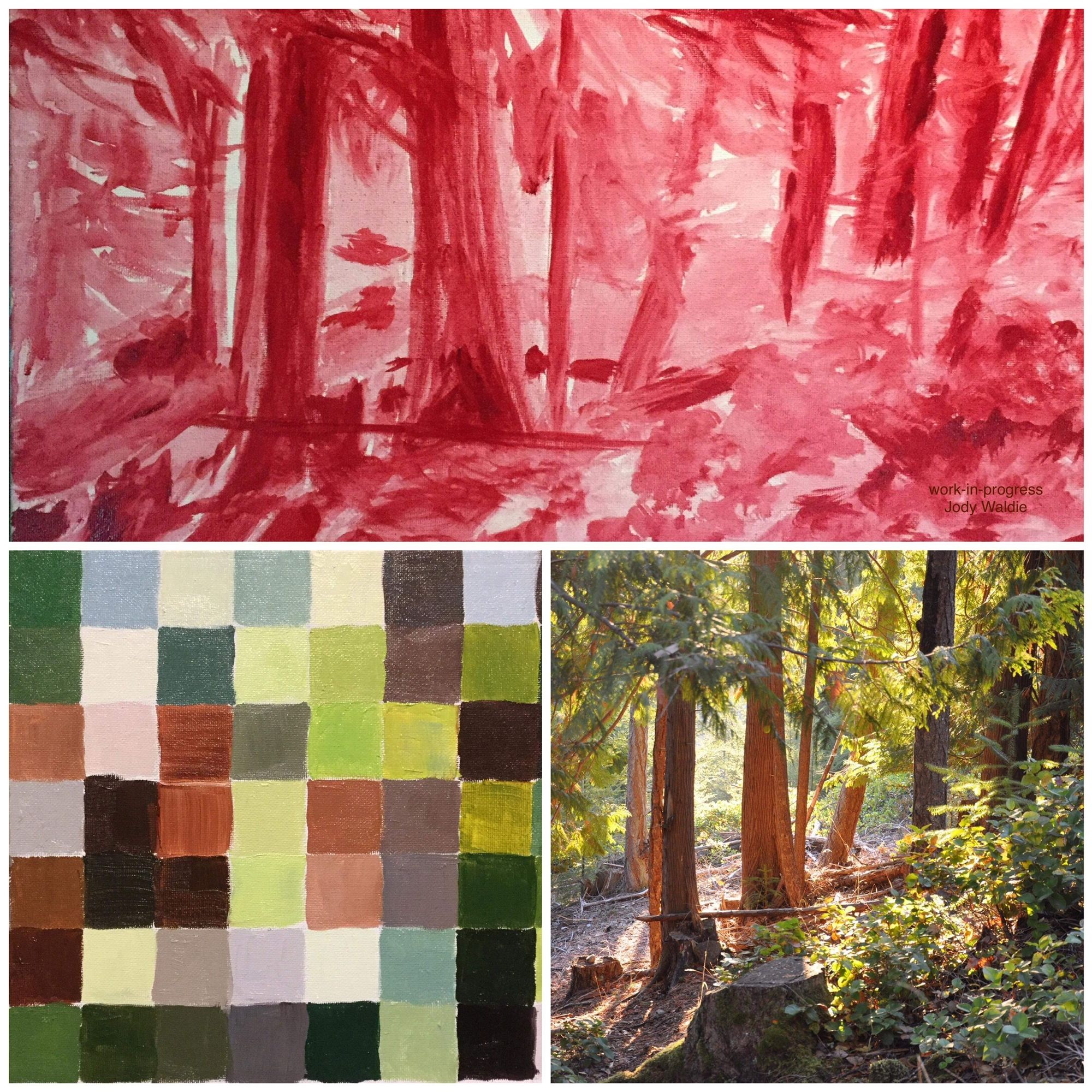
Here is the complete underpainting…
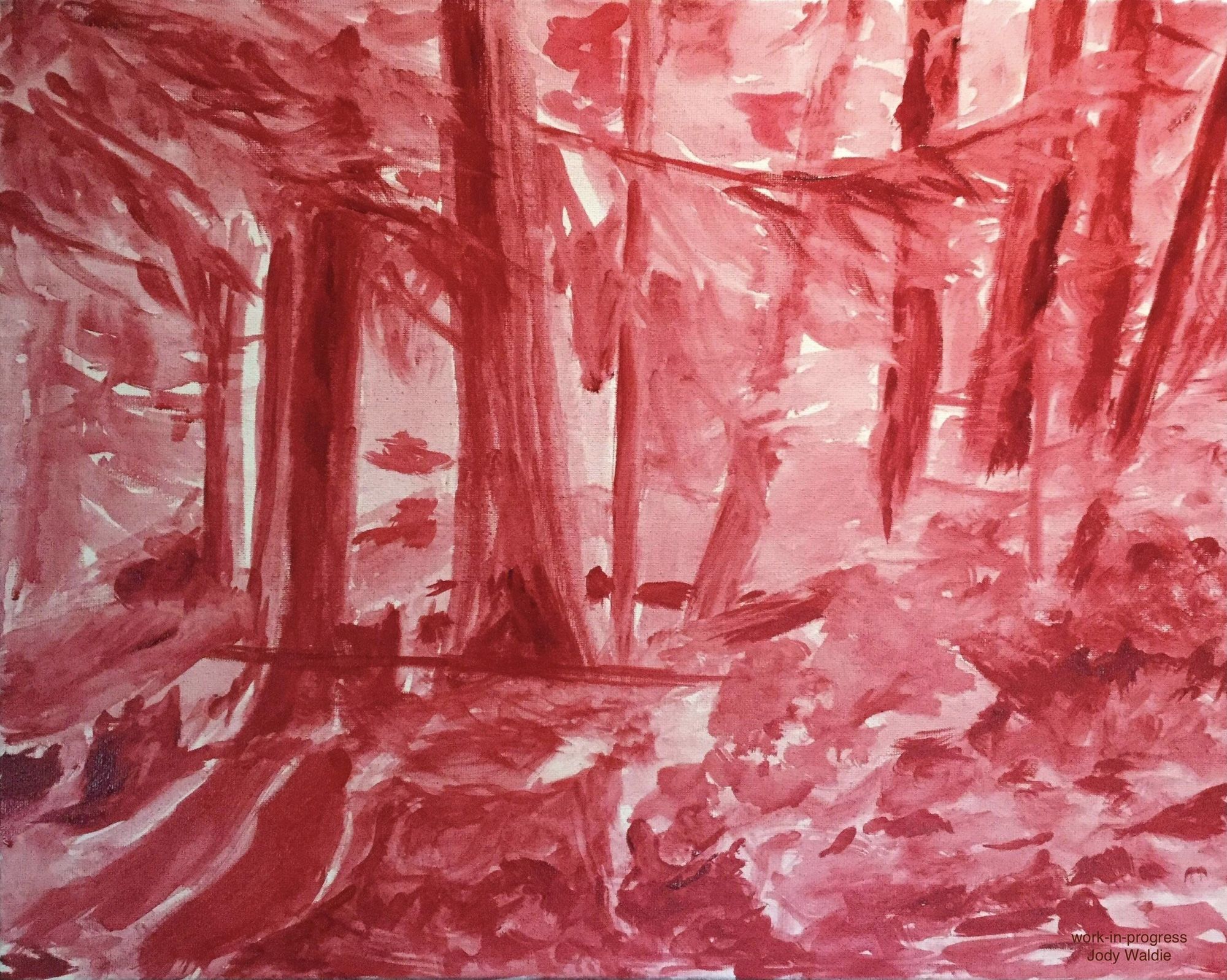
And here is the finished painting…

Jody Waldie | A Piece of Paradise (2019) | Available for Sale | Artsy
Available for sale from Terrill Welch Gallery, Jody Waldie, A Piece of Paradise (2019), Oil on canvas, 16 × 20 × 3/4 in
Next we have the underpainting for a 48 x 36 inch walk in the woods that was in the previous Arbutus Room show and is still available through the gallery.
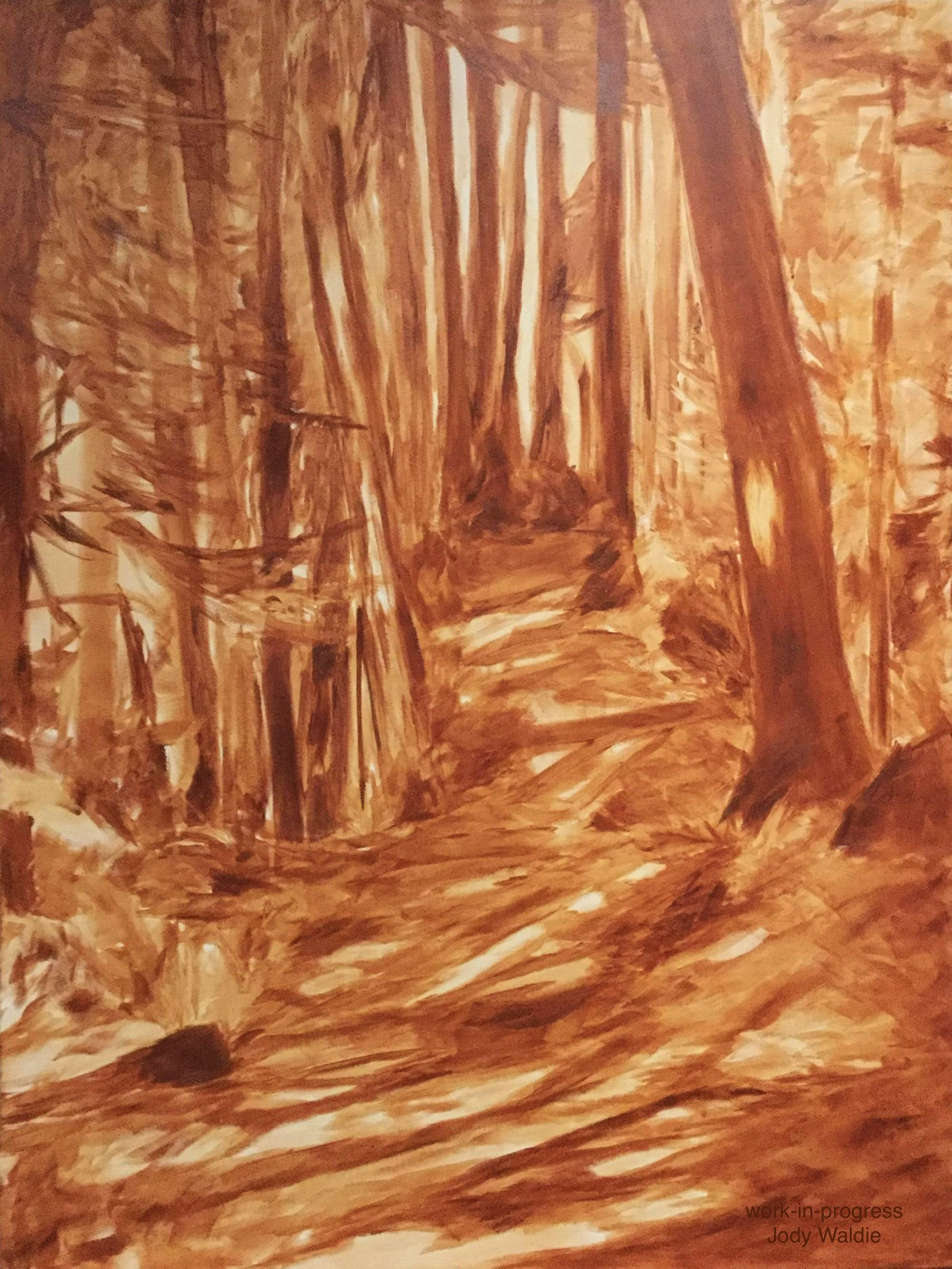
We can see the impact of this strong underpainting as Jody starts to block in the work…
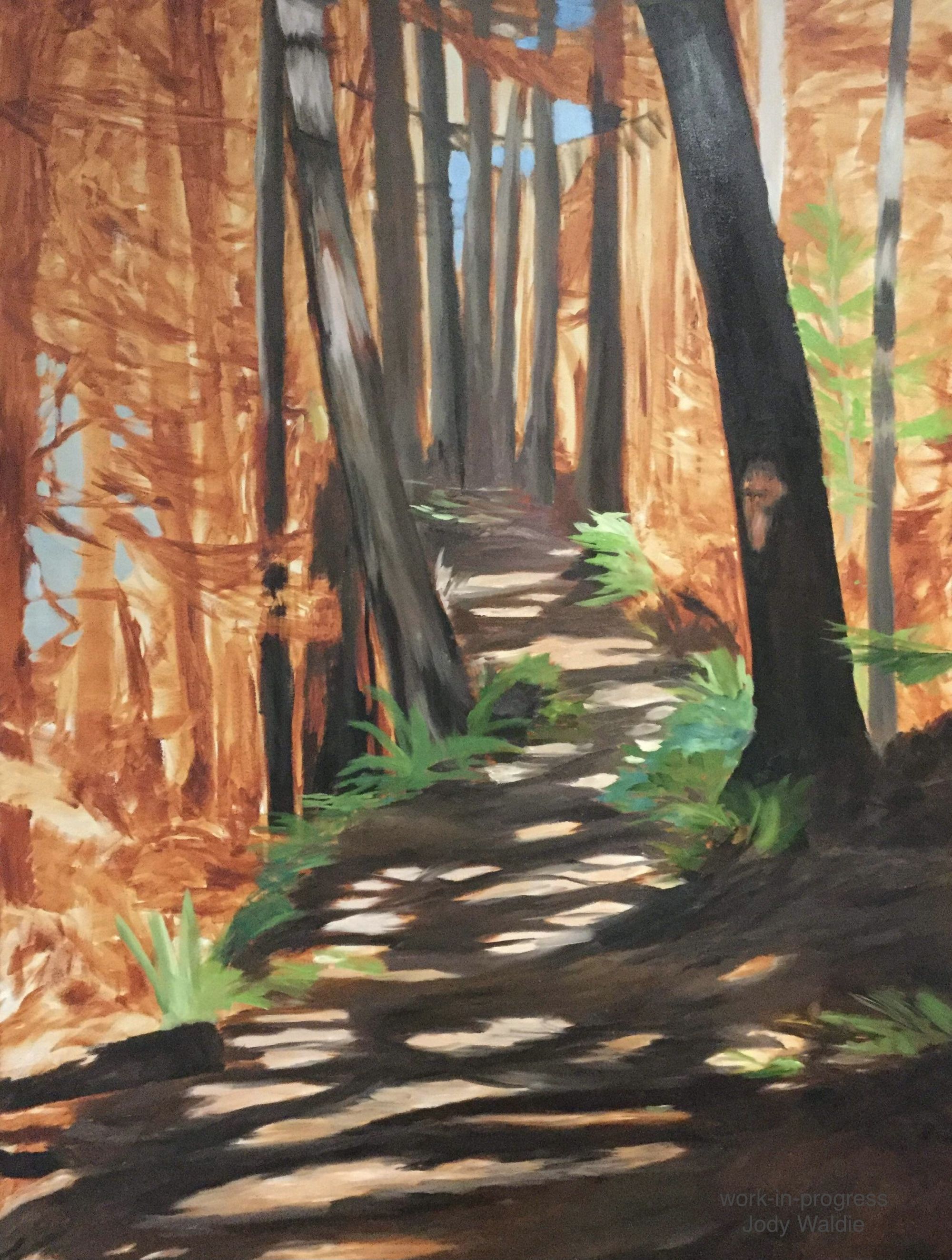
The finished painting is a real beauty and worth taking some time to go to our online gallery to see it in detail and in various room views at the link below…

Jody Waldie | Follow the Light (2021) | Available for Sale | Artsy
Available for sale from Terrill Welch Gallery, Jody Waldie, Follow the Light (2021), Oil on canvas, 48 × 36 in
Now for the final work…. it is the underpainting for a 38 x 48 inch seascape that I have always loved.
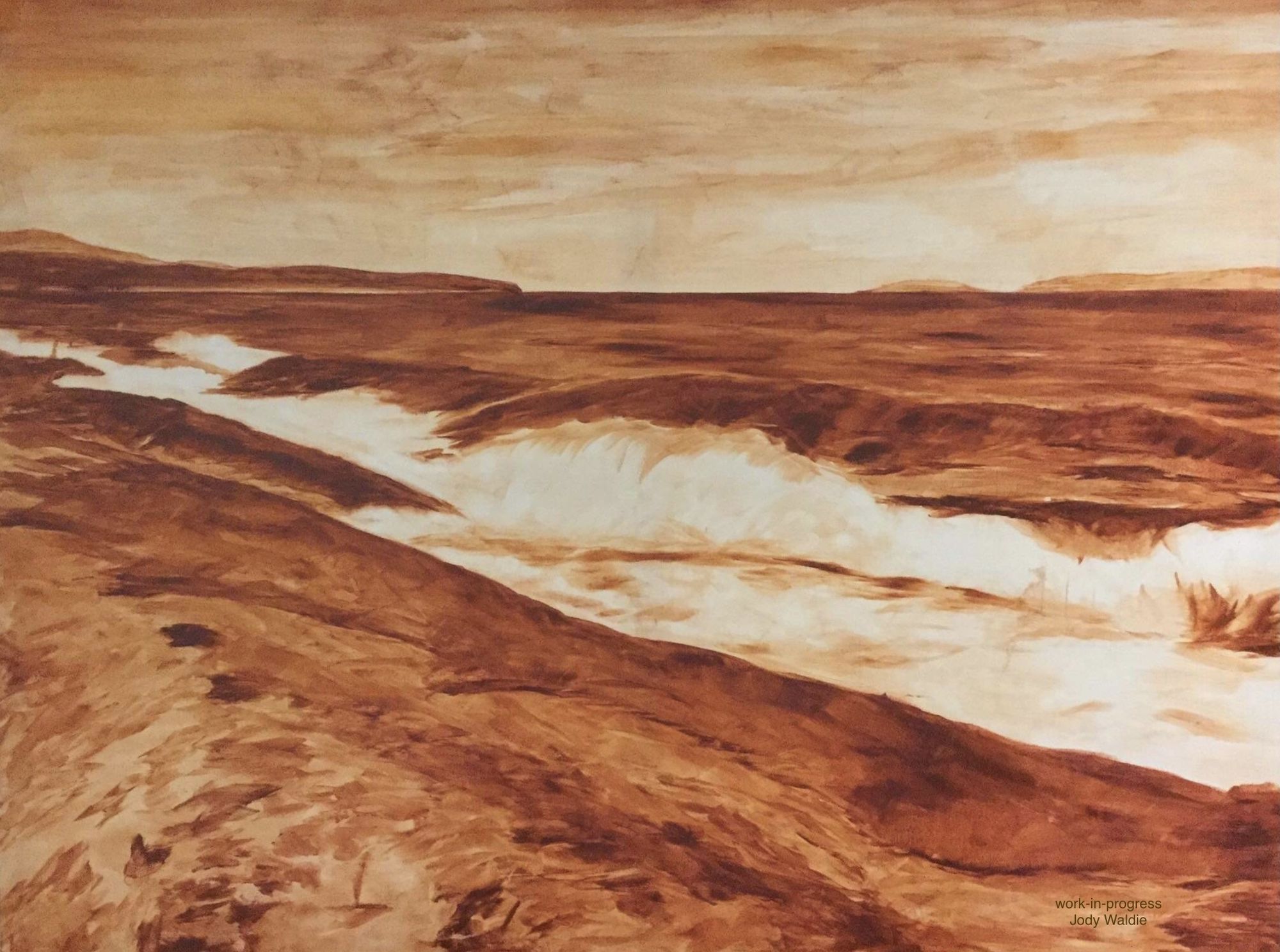
This painting is also still available through the gallery in our online gallery at the direct link below…

Jody Waldie | Georgia Strait (2019) | Available for Sale | Artsy
Available for sale from Terrill Welch Gallery, Jody Waldie, Georgia Strait (2019), Oil on Canvas, 36 × 48 in
We are often asked why do we bother with painting an underpainting when all we are going to do is paint over it! This is a fair question. However, the answer is possibly not as straight forward. A good underpainting can enhance the final effects of light in the overpainting. It can also help harmonize the colours in the overpainting. Finally, the underpainting is often poking through just a little allowing the colour underneath to blend with the overpainting when viewed from about six to eight feet. In the case of red and orange underpaintings, this can bring additional life and vibrancy to the greens and blues in the overpainting. Now you know some of our landscape painters’ secrets, look closely at your original paintings and see if you can tell what colour was used for the underpainting.
Held Over until August 29th - Stepping Lightly
I was going to change out the solo show in the Garden Room during the first week of August. However, we are just starting to get in person visitors. Therefore, I decided to leave it in place until at least the end of August. We have had many gallery visitors that have spent extended amounts of time enjoying the paintings in this show. So, if you haven’t had a chance to browse the show online or in person yet, we invite you to do so now…

Stepping Lightly: pandemic life within our landscape | Artsy
Through her paintings in this solo exhibition, Terrill Welch invites us to stand with her during this unique space and time, together. We shall open up in ways that we have never thought mattered, by design, filled with purpose, rising towards possibility. Do you dare?
Next to the Salish Sea
Of course, while you are browsing, you might as well stop by the “Next to the Salish Sea” group show in the Arbutus Room. It doesn’t hurt to look, does it? Just a wee browse is so refreshing and normalizing…. 😉

Next to the Salish Sea | Artsy
On our bellies leaning over a dock in Horton Bay, bracing against the winds in a storm to capture large rollers coming ashore or lengthening our stride along a forested seaside trail are all part of life on Mayne Island next to the Salish Sea.
What Has Sold
The little oil on paper postcard original painting has sold in England for the Twitter Art Exhibit International Fundraiser. I haven’t heard yet where it has gone. I trust it will have a good home no matter where it is in the world.
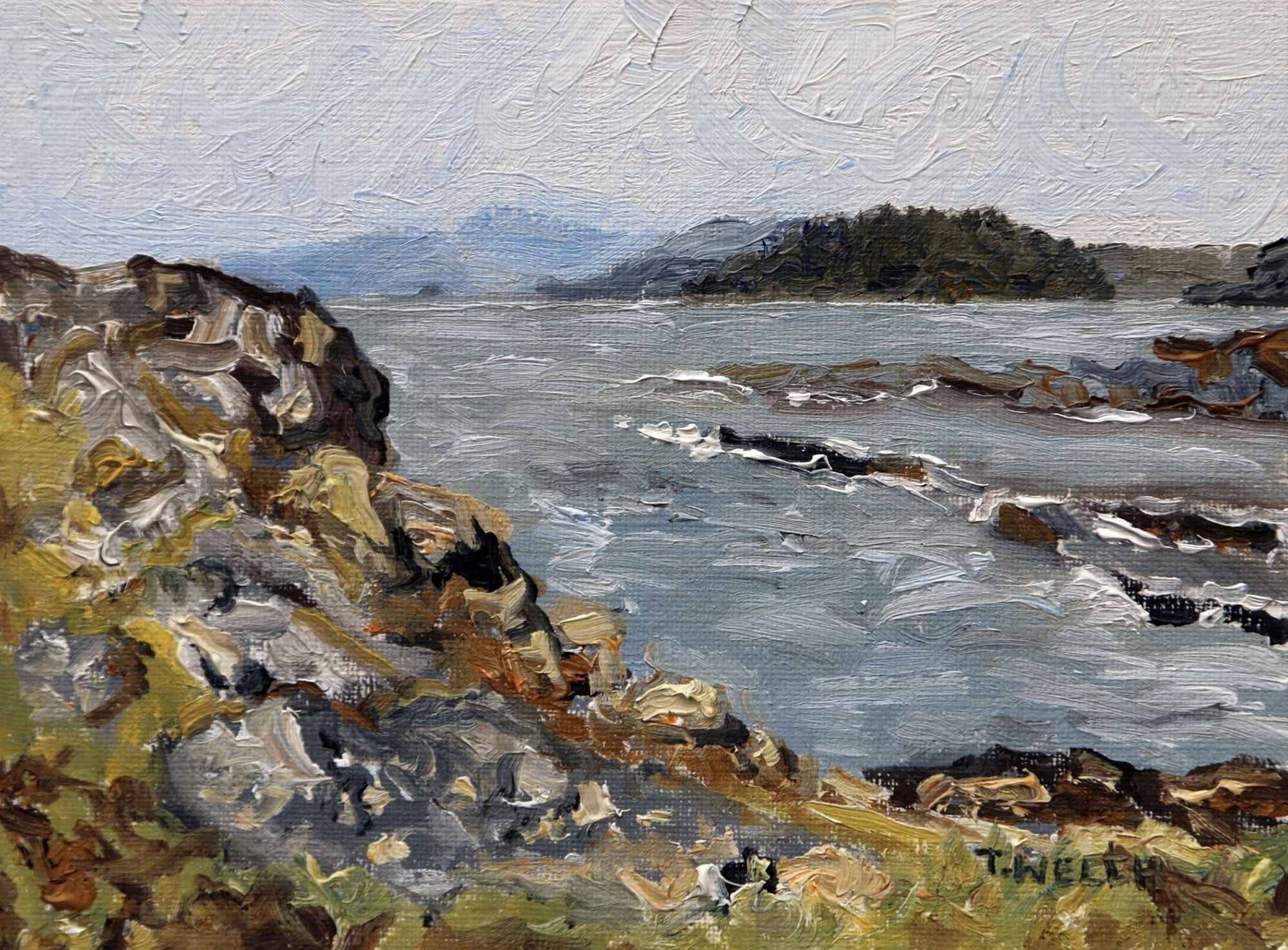
I always find it inspiring to participate in this event that was started way back in 2010 in Norway by artist and writer David Sandum (two of his paintings are in my personal art collection). The first exhibition’s goal was 140 entries, symbolic of the 140 characters used on Twitter. The response was so enthusiastic that 260 cards were submitted from 24 countries, and David Sandum raised enough funds to buy 221 new children’s books for a struggling library in Moss, Norway.
Now into its 12th year, Twitter Art Exhibit 2021 (TAE21) is curated by Cat Salter Smith and was hosted in Cheltenham, UK. The chosen charity to benefit from this global art exhibition is The Leukaemia and Intensive Chemotherapy Fund – LINC, located in Cheltenham, UK. LINC is a local charity that supports patients and families fighting blood cancer.
Until Next Time!
I am so enjoying those of you that have traveled over from Vancouver, Victoria or other parts of Canada to specifically drop into the gallery. I know more of you have told me of your plans to come this summer as well. It truly is something special to look forward to and such a joy to see everyone in person! Keep coming! I am for sure at the gallery from 11-2 Thursday and Saturdays and other days by chance or by appointment. It is good to book a week or even just a couple of days in advance for an appointment if it is outside of the Thursday and Saturday times. However, I will always do my best with short notice to open for you.
May your summer be filled with the things you enjoy most as we look up to see August coming quickly towards us!
Take good care!
Terrill 👩🎨🎨❤️

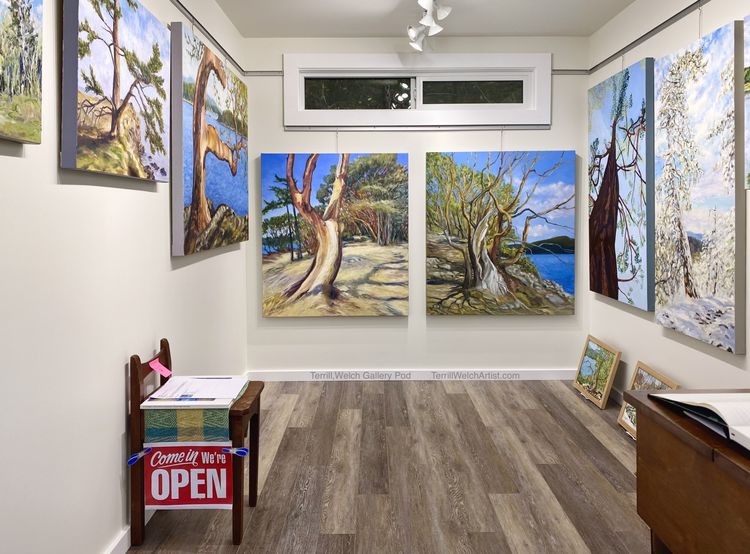
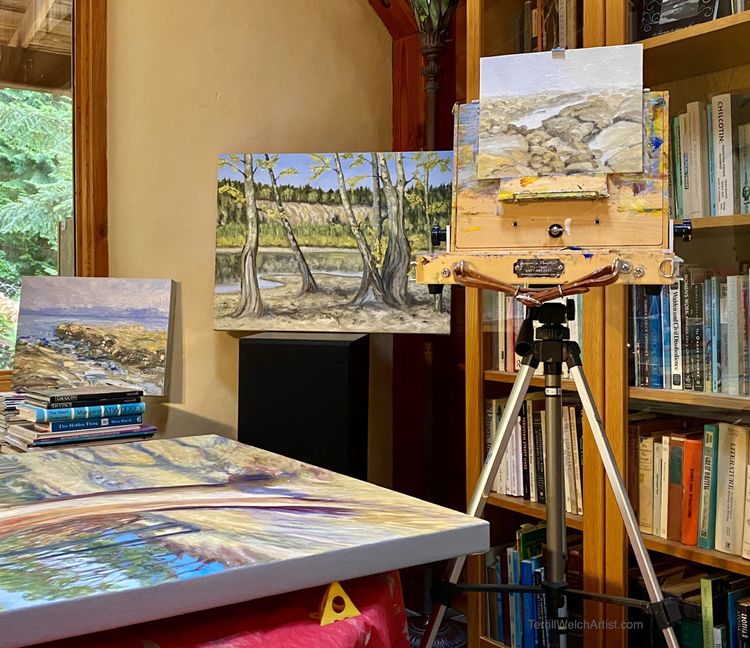
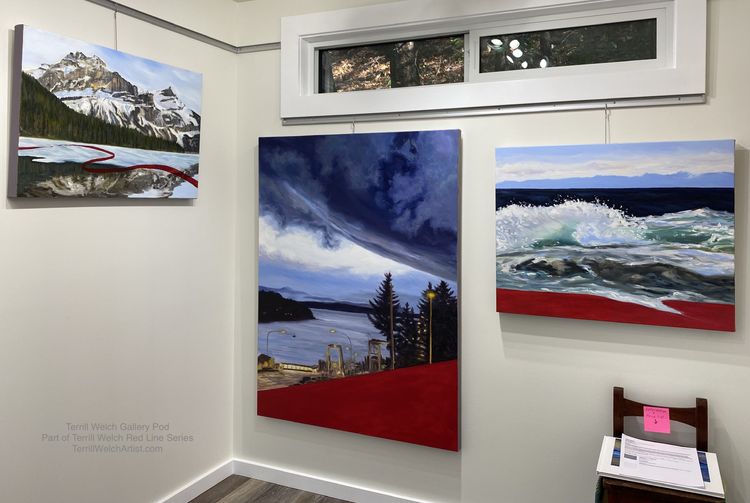
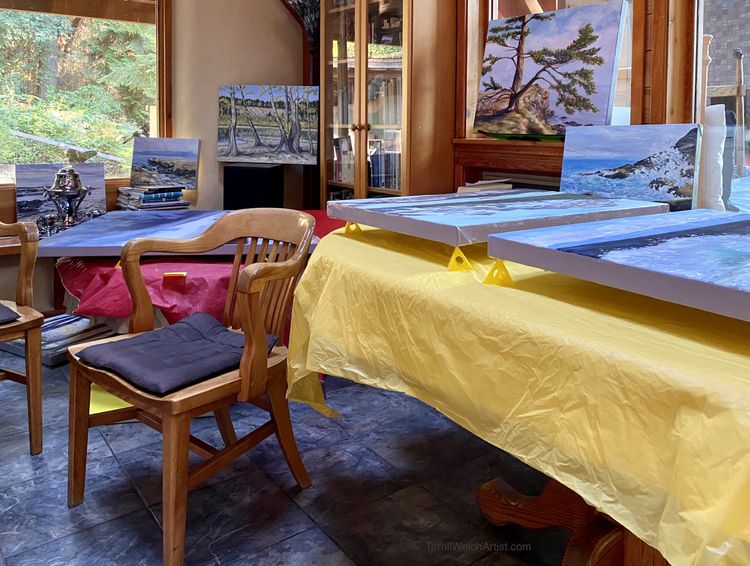
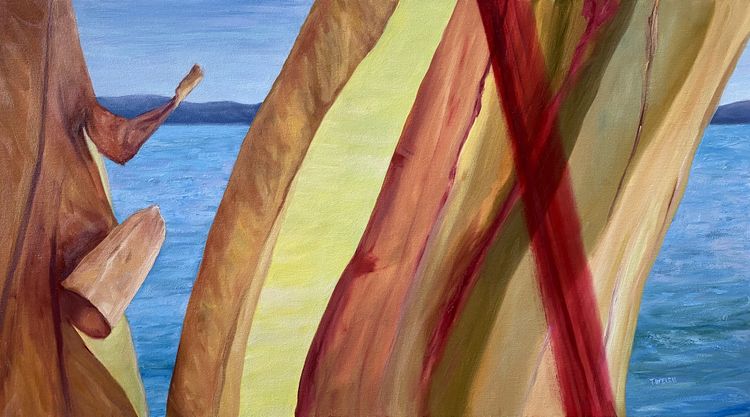
Member discussion